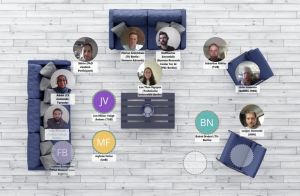If you stopped for a moment to think about it, you would quickly realize that the striking thing about the tools available for enabling remote work is that (by and large), they are the same tools that we used when we were in the office.
The big categories of tools are:
- Communication tools such as email, Slack, Teams, Zoom
- File sharing systems such as Google Drive, Microsoft SharePoint, Dropbox Business
- Tools that allow multiple people to work on one document: such as Google Suite, Office 365
- Project management tools such as Hive, Asana, and Trello
- Pulse survey tools such as TinyPulse, SurveyMonkey, Culture Amp, and many more
We are all relying on these tools more than before because employees can’t have hallway conversations when they are remote.
However, it is surprising that we don’t see more new technology.
So why is this?
Not all remote technology is nice
Sadly, one category of remote work tools that is increasing in popularity is employee monitoring.
These tools are often implemented because managers don’t trust their employees.
In the real world, it is not necessary to monitor most employees closely. But there are always a few cases of employees completely abusing the remote work option, and that pressurizes managers into adopting monitoring tools.
Metaverse-lite tech hasn’t taken off, but it should
When we think about the metaverse, we might think of totally immersive environments such as those possible with the new Apple Vision Pro or the Meta Quest headsets.
Maybe we’ll see those one day, but what is useful now, and I think underappreciated, are the ‘meta-verse lite’ tools.
Typically, these tools will allow participants to move around virtual rooms and talk to those people near them.
People are shown by a small video image so that one can see who is where in the different virtual rooms.
I’ve used some of these tools like HeyHubbub.com (below), Party.Space, and Katmai Tech (below, second down):


They create a feeling quite different from the typical Zoom or Teams meeting.
Moving forward with creating a connection
The well-established tools for collaboration, such as email and file sharing, do what they do well.
But what they don’t do, however, is build a sense of community and connection.
We have yet to see the long-term effects of remote work, but there is reason to fear that without new tools and processes, we will lose some of the sense of human connection and community that usually comes with sharing an office.
It may be that some of the metaverse-lite tools, used creatively, can provide that sense of community.
It may be that we will need other technologies, such as recognition systems or internal social media to do so.
What’s clear though, is that HR should be looking at using a variety of methods to create community among people who are largely working remotely.
Truth is, we were already remote, but we didn’t know it
One side-observation we can make, is that many employees were – in many ways – already working “remotely,” even when they were in the office.
These people might walk over to talk to someone now and then, but for the bulk of their communication, they would use Slack or email.
So just stop and consider this: You wouldn’t gather people in a meeting room daily to keep projects on track; you’d use project management software.
If there were multiple offices, these people would use Zoom or Teams for meetings – even if half the people were in the same office.
So, maybe the lack of exciting new remote tools is because we already had the main tools we needed.
